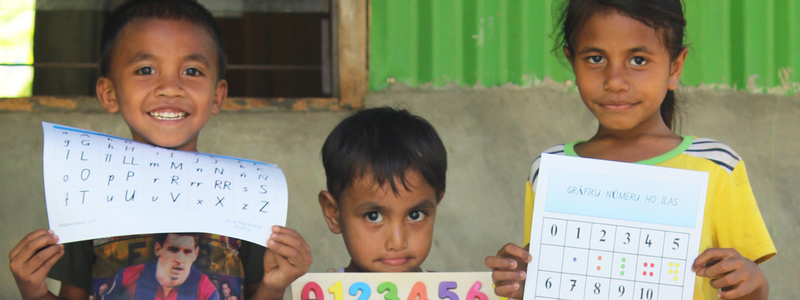
Fast Facts
- Around the world, approximately 258 million children and youth are not attending school, according to UIS data for the school year ending in 2018. The total includes 59 million children of primary school age, 62 million of lower secondary school age and 138 million of upper secondary age.[1]
- Over 600 million children and adolescents worldwide are unable to attain minimum proficiency levels in reading and mathematics, even though two thirds of them are in school. [3]
- Despite the steady rise in literacy rates over the past 50 years, there are still 773 million illiterate adults in the world, most of whom are women.[4]
- In third of countries with data, less than 80% of teachers are trained according to national standards in 2014.[5]
- Although Aboriginal and Torres Strait Islander people make up 2.7 per cent of the working age population in Australia, they only represent 1.1 per cent of all university enrolments
Why is Education important?
‘Education is possibly the best tool we have for tackling poverty. Literacy is at the heart of education and is a basic human right that we all deserve. When people have the chance to learn basic life and literacy skills economies grow faster and poverty rates decline. Everyone needs the opportunity to receive a quality education.’ World Literacy Foundation April 2012
 Education is more than learning to read and write; it is one of the most vital investments a nation can make in its people and their future. As well as being a fundamental human right, it is a well-known fact that education is a powerful driver of development, allowing individuals to reach their full potential and contribute positively to society. According to The World Bank, education is a human right, a powerful driver of development, and one of the strongest instruments for reducing poverty and improving health, gender equality, peace, and stability[6].
Education is more than learning to read and write; it is one of the most vital investments a nation can make in its people and their future. As well as being a fundamental human right, it is a well-known fact that education is a powerful driver of development, allowing individuals to reach their full potential and contribute positively to society. According to The World Bank, education is a human right, a powerful driver of development, and one of the strongest instruments for reducing poverty and improving health, gender equality, peace, and stability[6].
Education has the power to transforms lives. For example, if all students in low-income countries left school with basic reading skills, 171 million people could be lifted out of poverty, equal to a 12% cut in global poverty.[7] Children of educated mothers are more likely to be vaccinated and less likely to be stunted because of malnourishment[8], and if all mothers completed primary education, maternal deaths would be reduced by two-thirds, saving 189,000 lives.[9]
Ensuring children have access to education early in life is vital for their long-term development and ability to contribute to society. Studies in developing countries show that early childhood development programs lead to higher levels of primary school enrollment and educational performance, which in turn positively affect employment opportunities later in life. Despite this, nearly half the world’s children, particularly those from marginalised communities, are likely to miss out on education in their early years, often perpetuating a cycle of poverty.[10]
Tertiary Education is also extremely important for long-term development goals of nations. Studies have shown that tertiary education contributes to not only better job outcomes and higher salaries, but also results in more personal growth and a more fulfilling life[11]. Statistics show that individuals who have completed tertiary education are overall healthier, live longer and are more deeply engaged in civic and community life than those who have not completed university[12]. A research paper published by the Department for Business, Innovation and Skills[13] has evidence that nations experience better social cohesion, political stability and economic growth the more educated their citizens are. Those who have a Higher Education are more likely to vote and volunteer, and less likely to smoke or commit a crime. Those who have a tertiary education also have higher levels of tolerance and educate their children better than non-graduates
A good education for all is about more than just achieving high levels of school-enrolment rates – it is about ensuring that the quality of learning is high. For Mary MacKillop Today, just being able to access education is not enough; through our programs, we want to ensure that all children receive quality education in safe, effective and inclusive learning environments, both at home and at school.
What Mary MacKillop Today is doing to help improve education opportunities?
- Tetun Literacy and Teacher Training Program – Timor-Leste
- Mobile Learning Centre – Timor-Leste
- Parents Training Program – Timor-Leste
- Community work (Non-Development)
- Aboriginal and Torres Strait Islander Tertiary Scholarship Program- Australia
[1] Out-of-School Children and Youth, accessed http://uis.unesco.org/en/topic/out-school-children-and-youth
[2]Facts and Figures: Rural Women and the Millennium Development Goals’ (2012) UN Women Watch, accessed http://www.un.org/womenwatch/feature/ruralwomen/facts-figures.html
[3]Education – every child has the right to learn, accessed https://www.unicef.org/education
[4]Literacy, accessed https://uis.unesco.org/en/topic/literacy
[5]‘The World needs almost 69 million new teachers to reach the 2030 Education goals’ (2016) UNESCO, p11, accessed https://unesdoc.unesco.org/ark:/48223/pf0000246124
[6]‘Education Overview’ (2023) World Bank, accessed http://www.worldbank.org/en/topic/education/overview
[7] ‘Education Counts: Towards the Millennium Development Goals’ (2011) UNESCO P8.
[8]‘Education Counts: Towards the Millennium Development Goals’ (2011) UNESCO P19
[9]‘Education Transforms lives’ (2013) UNESCO, P7 accessed http://unesdoc.unesco.org/images/0022/002231/223115E.pdf
[10]‘Early Childhood Education and School Readiness’ (2012) UNICEF, accessed http://www.unicef.org/education/bege_61627.html
[11] ‘Why Higher Education Is Crucial for the Next Generation’ (2017) MEDIA PLANET, accessed http://www.educationandcareernews.com/higher-education/why-higher-education-is-crucial-for-the-next-generation
[12] ‘The Benefits of Higher Education’ (2016) Hastac, accessed https://www.hastac.org/blogs/jackkunis/2016/12/08/benefits-higher-education
[13] ‘The Benefits of Higher Education Participation for Individuals and Society: Key Findings and Reports “The Quadrants” (2013), Department for Business Innovation & Skills, accessed https://assets.publishing.service.gov.uk/government/uploads/system/uploads/attachment_data/file/254101/bis-13-1268-benefits-of-higher-education-participation-the-quadrants.pdf








